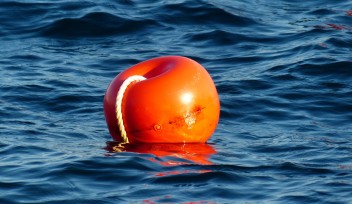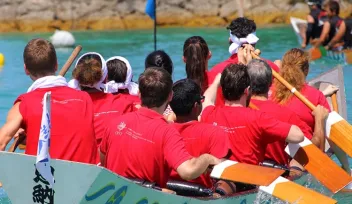Column: OIST researcher investigates how coral reefs impact tsunamis

The latest OIST column in the Asahi Shimbun GLOBE+ is out now. This month, science writer Dani Ellenby interviewed postdoctoral scholar, Marine le Gal, about her research on how coral reefs affect the impact of tsunamis.
The article is in Japanese, but the original English version can be read below.
OIST student investigates how coral reefs impact tsunamis
On March 11th, 2011, the Great East Japan Earthquake shook the world. One of the most powerful earthquakes since records began, with a magnitude of 9.0, it jolted the earth’s position on its axis and increased the planet’s rotational speed. But at well as the major damage caused by the main quake and aftershocks, further destruction lay in its wake. The energy released by the undersea earthquake displaced large volumes of water and resulted in a series of powerful and destructive waves: a tsunami.
As this tsunami approached the north-eastern coast of the Japanese main island of Honshu, the shallower ocean floor forced the waves to phenomenal and unprecedented heights. They surged over the protective sea barriers, flooded towns and claimed the lives of around 15,000 people.
A few years later, Marine le Gal, then a PhD student studying tsunami modelling at the Laboratoire d’Hydraulique Saint-Venant in Paris, visited Ōtsuchi. This rural town, located in the Tōhoku region, was still struggling with the devastation caused by the event. Half the town had been levelled and around 10% of its residents were reported dead or missing.

Nine years on from the disaster, Marine now works at the Okinawa Institute of Science and Technology Graduate University (OIST). She sat down with me and described her experience in Ōtsuchi.
“Meeting the people in Ōtsuchi and seeing the full extent of the damage had a huge impact on me – it was a revelation,” Marine told me. “It solidified my reasons for why I’m doing what I’m doing, to work on my modelling and to help us understand what conditions make a tsunami more severe. Maybe then we can reduce how damaging their impact is.”

Simulating tsunamis
Here at OIST, Marine is a postdoctoral scholar who studies historical tsunami events and creates numerical models that simulate them.
Her latest models simulate the Great Tsunami of Meiwa that hit the Ryukyu Archipelago almost 250 years ago. One of the most affected islands was Ishigaki, where around 9,000 people, over half of the island’s population, are believed to have died.
Even now, traces of the tsunami are still visible, with the Ishigaki coastline dotted with huge boulders that were dragged from the ocean by the waves.

The coral reefs surrounding Ishigaki are of particular interest to Marine. Reefs play an important role in dampening the energy of storm waves, but their influence on tsunami waves is more complex.
“Some research has found that coral reefs have a protective influence, whilst other research has shown that in certain circumstances, the reef can actually exacerbate the effect of the tsunami,” she explained. “That’s why it’s so important to do real-life simulations, rather than just using idealized models, so that you can understand what effect would occur in a specific location. That way you can plan ahead for future tsunami events.”

Creating a model that replicates a tsunami from the distant past is no easy feat. Marine used both satellite data and historical evidence and finetuned her model to imitate the real-life event as closely as possible. She then erased the reef from her simulation to see what would have happened if it had not been there.
“I found that along most parts of the coast, the reef played a crucial protective role. The impact of the tsunami was much more severe when the reef was removed. But there were also certain locations where the presence of the reef actually strengthened the tsunami waves.”
Marine found that these specific areas all coincided with gaps, or channels, in the reef. Just like how a magnifying glass can concentrate light waves to make a more intense beam, these gaps in the reef focused the tsunami waves, causing them to surge higher and further inland.

By pinpointing both protected and vulnerable areas of the coastline, Marine’s models are a crucial and valuable resource.
“These models can be used by experts involved in coastal management and development. It also means that the impact of the reef can be considered when predicting flooding caused by a future tsunami.”
The importance of the ocean
For Marine, studying tsunamis is only the first step in her goal to understand the ocean.
“I was born and raised next to the sea, and I’ve always been attracted towards understanding how the ocean moves – not just waves, like tsunamis, but also its currents and tides,” said Marine. “At OIST, I’ve started to expand my expertise into the broader field of oceanography, which has been challenging, but so rewarding. Ultimately, I want to contribute to how we can live in symbiosis with the ocean – to interact with it without damaging it.”

Although tsunamis represent one of the most destructive elements of the ocean, Marine emphasized the importance of the ocean to humanity’s survival. It’s fundamental to so many processes, from regulating the planet’s climate to the water cycle to the air we breathe, explained Marine.
“The ocean brings us enormous benefits. Meanwhile, we inflict so much damage on the ocean and to environments within it, like coral reefs,” she added. “But my research shows that as well as providing a home for sea life, the reef is also essential for our own protection. So, it’s really important to take care of it.”
Specialty













